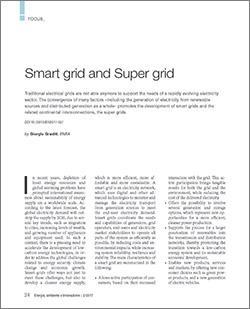
Smart grid and Super grid
by Giorgio Graditi, ENEA
DOI 10.12910/EAI2017-027
Traditional electrical grids are not able anymore to support the needs of a rapidly evolving electricity sector. The convergence of many factors –including the generation of electricity from renewable sources and distributed generation as a whole– promotes the development of smart grids and the related continental interconnections, the super grids
In recent years, depletion of fossil energy resources and global warming problems have prompted international awareness about sustainability of energy supply on a worldwide scale. According to the latest forecast, the global electricity demand will outstrip the supply by 2020, due to several key trends, such as migration to cities, increasing levels of wealth, and growing number of appliances and equipment used. In such a context, there is a pressing need to accelerate the development of low-carbon energy technologies, in order to address the global challenges related to energy security, climate change and economic growth. Smart grids offer ways not just to meet these challenges, but also to develop a cleaner energy supply, which is more efficient, more affordable and more sustainable. A smart grid is an electricity network, which uses digital and other advanced technologies to monitor and manage the electricity transport from generation sources to meet the end-user electricity demand. Smart grids coordinate the needs and capabilities of generators, grid operators, end-users and electricity market stakeholders to operate all parts of the system as efficiently as possible, by reducing costs and environmental impacts, while increasing system reliability, resilience and stability.
The smart management of the grid is the key point, allowing significant development perspectives of smart grids at local scale, and super grids at continental scale. This key point faces several challenges related to grid strengthening, enhanced intelligence, communication technologies and standardization, interoperability between different components and systems, integration of intermittent generation, moving offshore, and capturing the benefits of distributed generation and storage. …

